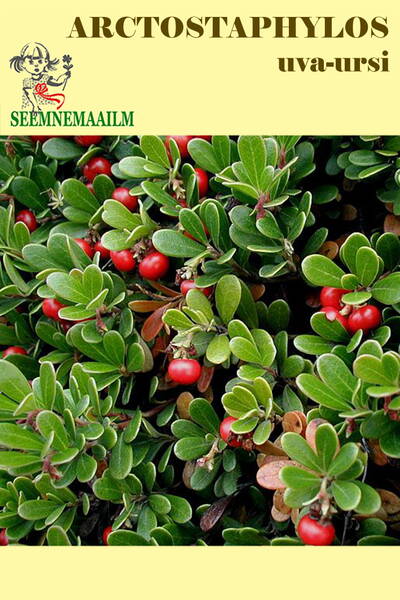An evergreen perennial from the Eriaceae family.
Origin: North America, Northern Eurasia.
Plant height: 5 cm.
Flower colour: white-pink.
Natural flowering period: March - May.
Winter hardiness zones: Z2 – Z8.
Soil requirements: dry.
Use: for rock garden.
1.0 g = 80 seeds.
These evergreen shrubs or small trees are natives to western North America, northern Europe and Mexico. Arctostaphylos uva-ursi (Bearberry or Kinnikinick) is a creeping, alpine shrub that is suitable for planting in rock gardens or along banks or sandy slopes. The green foliage of this attractive plant turns bronze in autumn, but becomes green again in the spring. In early to mid-summer, clusters of nodding, white flowers tinged with pink are produced. The flowers are followed by red, berry-like fruits. Arctostaphylos uva-ursi var. Vancouver Jade is a pretty variety with dark green, glossy foliage that turns red in the winter. Its flowers are pink.
Potting of arctostaphylos.
These plants can be grown in peaty or light, loamy soil, which is lime free, in a sunny location. They should be planted in early fall or spring. The trailing kinds may be pruned back in the spring if they ve outgrown their spaces.
Propagation of arctostaphylos.
The trailing kinds may be increased by inserting cuttings in sandy peat in a frame in the summer, or in a greenhouse in October. Seeds, of any variety, may be sown in the spring or fall, in pots filled with sandy peat. They should be grown in the pots until they are large enough to be planted outdoors.
Bearberry has adapted to harsh living conditions and is undemanding to soil. Its roots are located in the upper layer of sandy soil, but nevertheless provide the plant with everything it needs. Bearberry is so decorative that it is widely used in landscaping parks, gardens, and rock gardens.
Nature has generously endowed this plant with other properties, such as medicinal ones.
In Tibetan medicine, bearberry leaves are used for gastritis, increased acidity of gastric juice, and externally as a wound healing agent.
In folk medicine, it is used in teas and decoctions to treat urolithiasis, cystitis and other kidney diseases. Widely used in veterinary practice.
But the benefits of bearberry do not end there. Its leaves contain up to 35% tannins, which are used to make the best morocco and leather, coloring them gray and black.
Bearberry is very productive. From 1 hectare you can collect up to 25 centners of berries. In times of famine, people mixed flour from its berries into bread. Flour from its berries is still valued in baking and cooking.
Eng.: Bearberry, Sandberry, Kinnikinick, Mountain Box. Bot. syn.: Arbutus uva-ursi L.















